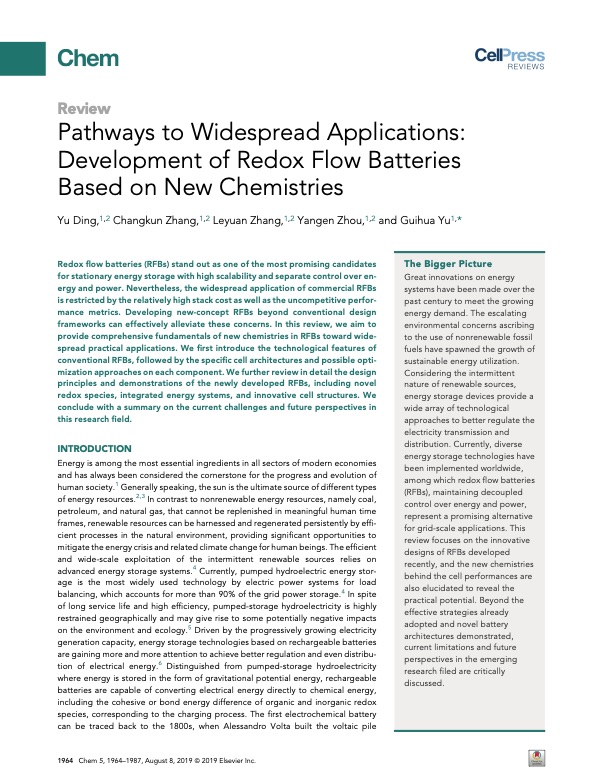
PDF Publication Title:
Text from PDF Page: 001
The Bigger Picture Great innovations on energy systems have been made over the past century to meet the growing energy demand. The escalating environmental concerns ascribing to the use of nonrenewable fossil fuels have spawned the growth of sustainable energy utilization. Considering the intermittent nature of renewable sources, energy storage devices provide a wide array of technological approaches to better regulate the electricity transmission and distribution. Currently, diverse energy storage technologies have been implemented worldwide, among which redox flow batteries (RFBs), maintaining decoupled control over energy and power, represent a promising alternative for grid-scale applications. This review focuses on the innovative designs of RFBs developed recently, and the new chemistries behind the cell performances are also elucidated to reveal the practical potential. Beyond the effective strategies already adopted and novel battery architectures demonstrated, current limitations and future perspectives in the emerging research filed are critically discussed. Review Pathways to Widespread Applications: Development of Redox Flow Batteries Based on New Chemistries Yu Ding,1,2 Changkun Zhang,1,2 Leyuan Zhang,1,2 Yangen Zhou,1,2 and Guihua Yu1,* Redox flow batteries (RFBs) stand out as one of the most promising candidates for stationary energy storage with high scalability and separate control over en- ergy and power. Nevertheless, the widespread application of commercial RFBs is restricted by the relatively high stack cost as well as the uncompetitive perfor- mance metrics. Developing new-concept RFBs beyond conventional design frameworks can effectively alleviate these concerns. In this review, we aim to provide comprehensive fundamentals of new chemistries in RFBs toward wide- spread practical applications. We first introduce the technological features of conventional RFBs, followed by the specific cell architectures and possible opti- mization approaches on each component. We further review in detail the design principles and demonstrations of the newly developed RFBs, including novel redox species, integrated energy systems, and innovative cell structures. We conclude with a summary on the current challenges and future perspectives in this research field. INTRODUCTION Energy is among the most essential ingredients in all sectors of modern economies and has always been considered the cornerstone for the progress and evolution of human society.1 Generally speaking, the sun is the ultimate source of different types of energy resources.2,3 In contrast to nonrenewable energy resources, namely coal, petroleum, and natural gas, that cannot be replenished in meaningful human time frames, renewable resources can be harnessed and regenerated persistently by effi- cient processes in the natural environment, providing significant opportunities to mitigate the energy crisis and related climate change for human beings. The efficient and wide-scale exploitation of the intermittent renewable sources relies on advanced energy storage systems.4 Currently, pumped hydroelectric energy stor- age is the most widely used technology by electric power systems for load balancing, which accounts for more than 90% of the grid power storage.4 In spite of long service life and high efficiency, pumped-storage hydroelectricity is highly restrained geographically and may give rise to some potentially negative impacts on the environment and ecology.5 Driven by the progressively growing electricity generation capacity, energy storage technologies based on rechargeable batteries are gaining more and more attention to achieve better regulation and even distribu- tion of electrical energy.6 Distinguished from pumped-storage hydroelectricity where energy is stored in the form of gravitational potential energy, rechargeable batteries are capable of converting electrical energy directly to chemical energy, including the cohesive or bond energy difference of organic and inorganic redox species, corresponding to the charging process. The first electrochemical battery can be traced back to the 1800s, when Alessandro Volta built the voltaic pile 1964 Chem 5, 1964–1987, August 8, 2019 a 2019 Elsevier Inc.PDF Image | Development of Redox Flow Batteries Based on New Chemistries

PDF Search Title:
Development of Redox Flow Batteries Based on New ChemistriesOriginal File Name Searched:
PIIS2451929419302207.pdfDIY PDF Search: Google It | Yahoo | Bing
Salgenx Redox Flow Battery Technology: Salt water flow battery technology with low cost and great energy density that can be used for power storage and thermal storage. Let us de-risk your production using our license. Our aqueous flow battery is less cost than Tesla Megapack and available faster. Redox flow battery. No membrane needed like with Vanadium, or Bromine. Salgenx flow battery
| CONTACT TEL: 608-238-6001 Email: greg@salgenx.com | RSS | AMP |